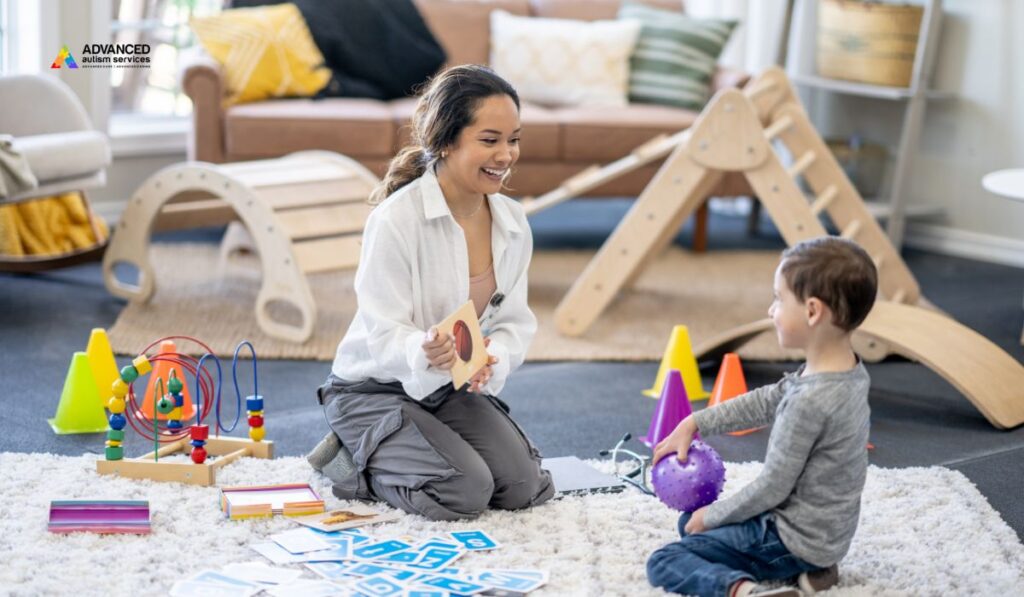Applied Behavior Analysis (ABA) therapy is a widely recognized and evidence-based approach to support individuals with autism spectrum disorder (ASD) in developing various skills and behaviors. While ABA therapy is commonly conducted in clinical settings, it can also be implemented at home, including ABA home therapy in Phoenix, AZ, to reinforce learning and foster generalization of skills. In this article, we will explore how to implement effective ABA therapy strategies at home to better support individuals with ASD.
Understanding ABA Therapy:
ABA therapy is rooted in the principles of behaviorism, focusing on observable and measurable behaviors. The primary goal is to increase desired behaviors while reducing unwanted behaviors through systematic interventions. ABA therapy breaks down skills into smaller, manageable tasks, allowing individuals to learn at their own pace.
Creating a Structured Environment:
One of the key aspects of ABA therapy is maintaining a structured and predictable environment. Establishing routines and consistent schedules can help individuals with ASD feel more secure, reducing anxiety and promoting learning. Designate specific areas for various activities to signal transitions and minimize distractions.
Setting Clear and Achievable Goals:
Identifying specific, measurable, achievable, relevant, and time-bound (SMART) goals is crucial for ABA therapy at home. Work closely with a qualified behavior analyst to create a personalized plan tailored to the individual’s needs. Break down larger goals into smaller, manageable steps to facilitate the learning process.
Utilizing Reinforcement Strategies:
Positive reinforcement is a cornerstone of ABA therapy. Identify meaningful reinforcers, such as preferred activities, toys, or praise, to motivate the individual. Consistently reinforce desired behaviors to increase the likelihood of their recurrence. Be attentive to individual preferences, as reinforcers can vary from person to person.
Implementing Prompting and Fading Techniques:
Prompting involves providing assistance or cues to help the individual perform a task. Gradually fade prompts as the individual becomes more proficient in the skill. This promotes independence and ensures that the individual is learning the target behavior, not just relying on prompts.
Collecting Data and Monitoring Progress:
Data collection is an integral part of ABA therapy to assess progress and make data-driven decisions. Create a simple data collection system to track behaviors, successes, and challenges. Regularly review the data with the behavior analyst to make necessary adjustments to the intervention plan.
Incorporating Generalization and Maintenance:
ABA therapy at home should aim for generalization, ensuring that learned skills transfer to various settings and contexts. Incorporate activities that encourage the application of skills in different environments. Additionally, focus on maintenance by periodically reviewing previously learned skills to prevent regression.
Collaborating with Professionals:
While ABA therapy at home is feasible, collaboration with qualified professionals is essential. Consult with a certified behavior analyst or ABA therapist to develop and modify intervention plans. Professionals can provide guidance, training, and support to ensure the effective implementation of ABA strategies.
Expanding Support Networks:
In addition to collaboration with professionals, it is crucial to involve other family members, caregivers, and educators in the implementation of ABA therapy at home. Creating a consistent approach across various settings ensures that the individual receives continuous support and reinforcement for their efforts.
Establishing Clear Communication Channels:
Effective communication is paramount when implementing ABA therapy at home. Regularly share information with all stakeholders involved, including therapists, teachers, and family members. Discuss progress, challenges, and any modifications needed in the intervention plan. Open communication fosters a unified and supportive approach to the individual’s development.
Addressing Challenging Behaviors:
ABA therapy also involves addressing challenging behaviors effectively. Conduct a functional behavior assessment to understand the triggers and functions of problematic behaviors. Develop behavior intervention plans that focus on teaching alternative, more appropriate behaviors while systematically reducing unwanted ones. Consistency in implementing these plans is key to success.
Promoting Social Skills:
Social skills are often a focal point of ABA therapy. Create opportunities for social interactions at home, incorporating siblings, friends, or family members into structured activities. Use role-playing and social stories to teach and reinforce appropriate social behaviors, enhancing the individual’s ability to navigate social situations successfully.
Adapting Strategies for Different Ages:
A crucial aspect of implementing ABA therapy at home is recognizing that strategies may need to be adapted based on the individual’s age and developmental stage. Tailor activities and expectations to align with the individual’s abilities and interests, ensuring that the intervention remains engaging and relevant.
Fostering Independence:
ABA therapy emphasizes promoting independence and life skills. Incorporate daily living activities into the home routine, such as self-care tasks, meal preparation, and household chores. Gradually fade prompts as the individual becomes more proficient, empowering them to take on more responsibilities and enhance their overall independence.
Remaining Flexible and Responsive:
Flexibility is key when implementing ABA therapy at home. Be prepared to adapt strategies based on the individual’s progress and changing needs. Regularly assess the effectiveness of interventions and make necessary adjustments to ensure continued growth and development.
Celebrating Achievements:
Positive reinforcement is not only a strategy but also a mindset. Celebrate small victories and achievements along the way. Acknowledge the individual’s efforts, no matter how incremental, to boost motivation and self-esteem. A positive and encouraging environment contributes significantly to the success of ABA therapy at home.
Conclusion:
In conclusion, implementing effective ABA therapy strategies at home is a dynamic and collaborative process. By creating a structured environment, setting clear goals, collaborating with professionals, and involving a supportive network, individuals with ASD can make significant strides in their development. Addressing challenging behaviors, promoting social skills, and fostering independence contribute to a comprehensive and holistic approach to ABA therapy at home.
With dedication, consistency, and a focus on celebrating achievements, families can create an environment that supports the overall well-being and growth of individuals with autism spectrum disorder. For personalized guidance and support in implementing ABA therapy strategies at home, feel free to reach out to the experts at Advanced Autism Services. Contact us at Advanced Autism Services for more information on how we can assist you and your loved one on this journey.
FAQs
What is ABA therapy, and how does it benefit individuals with autism spectrum disorder (ASD)?
Applied Behavior Analysis (ABA) therapy is an evidence-based approach focused on behaviorism principles, aiming to increase desired behaviors while decreasing unwanted ones. It is particularly effective in supporting individuals with ASD by breaking down skills into manageable tasks and promoting learning at their own pace.
Can ABA therapy be implemented at home, or is it limited to clinical settings?
ABA therapy is commonly conducted in clinical settings, but it can be successfully implemented at home. In fact, extending ABA strategies to the home environment reinforces learning and enhances the generalization of skills, contributing to a more comprehensive approach to therapy.
How does creating a structured environment contribute to the effectiveness of ABA therapy at home?
Maintaining a structured and predictable environment is a key aspect of ABA therapy. This helps individuals with ASD feel secure, reduces anxiety, and promotes learning. Establishing routines and consistent schedules, along with designated areas for various activities, signals transitions and minimizes distractions.
What are SMART goals, and why are they crucial in ABA therapy at home?
SMART goals are specific, measurable, achievable, relevant, and time-bound objectives. They are essential in ABA therapy at home as they provide a clear roadmap for individualized plans, ensuring that interventions are focused, attainable, and conducive to the learning process.
How important is positive reinforcement in ABA therapy, and how can it be personalized?
Positive reinforcement is a cornerstone of ABA therapy, motivating individuals to repeat desired behaviors. It involves identifying meaningful reinforcers such as preferred activities, toys, or praise. Personalization is key, as reinforcers vary from person to person, making them more effective and impactful.
What is prompting, and how does fading techniques contribute to independence in ABA therapy?
Prompting involves providing assistance or cues to help individuals perform a task. Fading techniques gradually reduce these prompts as the individual becomes more proficient, promoting independence and ensuring genuine learning of the targeted behavior rather than dependence on prompts.
Why is collaboration with professionals crucial in ABA therapy at home?
While ABA therapy at home is feasible, collaboration with certified behavior analysts or ABA therapists is essential. Professionals offer guidance, training, and support to develop and modify intervention plans, ensuring the effective implementation of ABA strategies tailored to the individual’s needs.
How can families involve a broader support network in implementing ABA therapy at home?
In addition to professionals, involving family members, caregivers, and educators in a consistent approach across various settings ensures continuous support and reinforcement for the individual’s efforts, contributing to the success of ABA therapy at home.
What role does communication play in implementing ABA therapy at home?
Effective communication is paramount. Regularly sharing information with therapists, teachers, and family members fosters a unified and supportive approach. Discussing progress, challenges, and modifications ensures everyone is on the same page in supporting the individual’s development.
How can ABA therapy effectively address challenging behaviors at home?
ABA therapy addresses challenging behaviors through functional behavior assessments, and understanding triggers and functions. Behavior intervention plans focus on teaching alternative, more appropriate behaviors while consistently implementing strategies to reduce unwanted behaviors.
How does ABA therapy promote social skills, and what strategies can be used at home?
Social skills are a focus of ABA therapy. Creating opportunities for social interactions, incorporating siblings, friends, or family members, and using role-playing and social stories are effective strategies to teach and reinforce appropriate social behaviors at home.
Why is adapting ABA therapy strategies for different ages important?
Recognizing that strategies need adaptation based on age and developmental stage ensures that activities and expectations align with the individual’s abilities and interests. This keeps the intervention engaging and relevant throughout different life stages.




